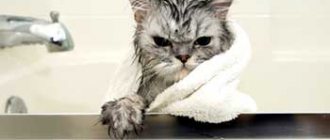Why and how often should cats be washed?
Most pets are exemplary cleanliness. Their tongue is able to clean the fur in a way that any washcloth would envy. But still, over time, the fur can stick together, begin to smell bad and become covered with a layer of fat.
You need to wash it if:
- the animal is not very clean;
- the cat got dirty somewhere;
- the wool began to smell;
- there are fleas and ectoparasites on the body.
The frequency depends on the cleanliness of the cat, the thickness of the coat and the time of year. Long-haired breeds are prone to matting, so they need to be washed more often.
Domestic cats can be bathed approximately 1-2 times a year. Cats that walk along the street - once every 3 months.
DO NOT wash animals:
- during illness;
- if the room is cold or there are drafts;
- if the cat is too afraid of this procedure, severe stress can lead to serious illnesses.
How to properly wash a cat
You need to prepare a large towel and detergent in advance. It is advisable to remove all unnecessary objects from the bathroom, close the door and window from drafts.
The washing itself should take place at a comfortable temperature - about 35-37 degrees. If your pet is very hot or cold, he may get scared, especially if he is afraid of water. Fill the bath to 20-30 centimeters, slowly lower the animal into it. It is recommended to take it by the withers, there is a pain-free zone. Next, thoroughly wet the skin, making sure that water does not get into your eyes, nose, or ears.
Squeeze a little shampoo into your palm, then lightly massage the fur with rubbing movements. It is allowed to use a soft brush. It is more convenient to bathe a domestic cat using a shower hose with a gentle pressure of warm water. If necessary, you can soap again. Then rinse the fur thoroughly to remove any remaining detergent and dry the animal well.
Optimal water temperature
It is very important to prepare comfortable water for bathing your pet. You must adhere to the following rules:
- very hot water can burn delicate skin, it would be correct to set the indicator to 40 degrees (depend on the breed). If your pet is trembling, it means the water is too cold for him;
- The room where the cat will take a bath should be warm, at least 23 degrees Celsius. To determine the temperature, be sure to use a thermometer, not your palm or elbow.
Contraindications for swimming
There are cases when washing pets is prohibited:
- in the postoperative period. Full recovery usually takes a month or a month and a half;
- in the late stages of a cat's pregnancy. You should not wash her at this time, stress can cause premature birth;
- after vaccination, within 14 days. Veterinarians believe that immunity is weakened at this time;
- When an animal is sick, washing can make the condition worse.
If the pet owner is concerned, water treatments should be canceled.
Drying wool after bathing
A washed animal should be wrapped in a terry towel or sheet. For long-haired breeds, prepare an additional diaper to completely absorb moisture. You can dry the fur with a hairdryer if sharp sounds do not frighten the “murka”. It is better to set the device to a warm air supply; a very hot flow can cause burns. To prevent the animal from catching a cold, there is a condition - you need to leave it for 1 hour in a warm room.
How to wash your cat's eyes and ears
Accumulation of wax in your pet's ears is normal. No need to try to pick it out all the time. This procedure is carried out once a month. For cleaning, a special gel is used; it is instilled into each ear according to the instructions. The dirty flakes will flow out after a while. Then the owner can wipe the inside of the sink with a piece of gauze bandage. If the animal is nervous, you should wait rather than force it into an unpleasant operation.
There is no need to clean your eyes unless necessary. This should be done when the “purr” has excessive lacrimation or suppuration in the eyes. You can buy drops at a veterinary pharmacy; they are calculated in the required dosages. It is also permissible to use furatsilin at home - 0.02% aqueous solution (1 to 5). Moisten a sterile napkin with the medicine and wipe the eyes of your furry friend.
What you need to bathe cats
Human shampoos are not suitable for washing. The pH of human and cat skin is different. The wrong cleanser can lead to dry skin, dandruff and even ulcers.
To bathe, you must purchase a special shampoo for cats in advance. If your pet has fleas, the detergent should have an antiparasitic effect.
Water temperature is about 37 C°. You will also need two towels to catch the water from the wool.
If your animal is terribly afraid of water, it is better to buy dry shampoo. The powder is applied to the coat and then combed out. It will collect dirt and grease, and also maintain friendship between the cat and the person.
Short-haired cats can be wiped with a wet towel. It will remove dirt and loose hair.
How to bathe cats correctly
Before the procedure you need to prepare:
- Feed the animal 2-3 hours before washing and do not give it any more food. Stress may cause your pet to vomit.
- Trim his nails. This will protect you from injury.
- Remove all objects from the bathroom that the cat could knock over and break.
- Place a mat or towel on the bottom of the bathtub. This is necessary so that the animal does not slip and feels confident.
- Brush your pet and untangle the tangles.
When everything is ready, pick up the cat and take her to the bath. Place it on the bottom and hold it with a confident hand. Loosen your grip, and the animal will immediately take advantage of this and jump out. But under no circumstances cause pain!
Gently wet the fur with a gentle stream of water from the shower. Strong pressure and noise will scare your pet. You can water it with water from a basin. It is important that the liquid does not get into the nose and ears. The latter can be plugged with cotton balls.
Then lather the cat's body and massage. The chin and paws are washed last. Rinse thoroughly with water. If necessary, repeat lathering.
At the end of the procedure, you can apply conditioner. It will help wash away any remaining shampoo and make the coat soft and shiny.
It is important to speak kindly to your pet while washing. Movements should be careful but confident.
Upon completion of the water procedures, squeeze the water out of the fur, wrap the cat in a towel and take it out of the bath. Then place it on a second towel, wrap it around it and gently rub the fur.
It is not necessary to dry your cat. It will dry itself perfectly. You can use a hairdryer if:
- the animal is not afraid of him;
- the house is cold;
- the day before the exhibition.
The air stream from the hair dryer should be at a temperature of about 40 C°. You cannot blow in the face - this is a threat to the cat.
Rules for swimming
To make your cat feel comfortable and not be afraid of water procedures, doctors recommend adhering to the following rules:
- 3-4 hours before the procedure, take a bowl of food from him; a hungry animal will tolerate stress more easily. For this, after bathing, feed him with his favorite treat.
- Brush the fur to remove loose and tangled hairs. This will make it easier for you to tidy it up after drying.
- Prepare all bathroom accessories a couple of hours before the procedure. Cats are smart animals; if they suspect that you are preparing for something, they will definitely hide.
- To distract the kitten from fear, throw rubber toys into the water.
- Be gentle, careful and persistent. Talk to your little friend and under no circumstances raise your voice.
- Seek the help of a second person if the four-legged dog strongly resists. During bathing, one will fix his position, and the other will do the washing.
- For the first bath, it is better not to use the shower. The sound of clanking water around will definitely frighten the kitten and develop a fear of water.
- Water should not get into your pet's ears. Cover them with cotton balls or wear a special cap.
- The water level can reach up to the chest; however, place a mat or towel on the bottom of the container to prevent the cat from sliding its paws, creating panic.
- To bathe your cat, bring the water temperature to the optimal temperature of +38°C. Depending on the breed, it may vary slightly.
- Dilute the soap solution from this water and a special product in a ratio of 1:3.
- The liquid is transferred by a cup (ladle) and poured onto the fur without sudden movements.
- For long-haired dogs, you can use conditioner. It is applied after rinsing off the shampoo and left for a few minutes. Your pet's coat will be smooth and shiny.
- While the pet is wet, keep the air temperature at least +23°C. Keep it in a towel and dry it with a hairdryer until the moisture has completely evaporated.
Treat for your pet after bathing
Correct temperature, suitable shampoo, preliminary preparation of the room. Show due patience and respect for your four-legged dog, then these simple rules will help your little friend enjoy the washing procedure and prevent him from becoming mentally or physically upset.
Kitten's first bath
You should start bathing a kitten at 4 months of age, not earlier. Babies are extremely sensitive to temperature changes, and improper bathing can lead to serious consequences.
You can start training 2 weeks after the complete change of teeth. For the process to go smoothly, you need to convince the kitten that water is not dangerous. To do this, place a bowl of water in the room and throw rubber toys there. The baby will become interested and try to play with them.
Then you can wash your paws, under the tap or in a basin. Pour some water into it and place the kitten. If the baby does not run away in panic, he is already ready for water procedures.
If fear is present, you can distract your baby with squeaky toys while washing. If you have a helper, ask him to blow soap bubbles. While the kitten is watching them, you can have time to wash it completely.
Preparing to wash
You need to wash your cat only when the animal is healthy and not under stress. In order to make the procedure easier for your pet to tolerate in the future, it is important to gradually accustom him, starting from the earliest months. Experts recommend starting to get accustomed to water procedures after the process of replacing temporary teeth with permanent ones.
There is no need to wash your cat often, but only when it gets dirty. Accustoming a kitten to water can be started gradually, initially by dipping only the animal’s paws. The first procedure is carried out only a month after the complete replacement of teeth has occurred.
Little kittens are not particularly clean due to the fact that they are quite curious and can get dirty. Depending on the degree of contamination of the coat, water procedures are prescribed. You need to remember that you cannot wash a cat with regular shampoo, especially a small kitten. In addition to the fact that human shampoo provokes dry skin in an animal, it can cause an allergic reaction due to the high content of surfactants.
There are also contraindications for swimming. It is not recommended to bathe small kittens until their baby teeth have been replaced. It is forbidden to give cats water treatments immediately after routine immunization. It is also not recommended to bathe a cat in quarantine. A contraindication to swimming is the weakening of the immune defense during illness. This is due to the fact that for a cat the bathing process is still stressful and can aggravate the course of the underlying disease.
Cats do not need to be bathed during the period of bearing kittens, only in the most emergency situations. Otherwise, you can cause problems during pregnancy.
Adult cat's first bath
An adult cat may react violently to attempts to place it in water. Therefore, patience is needed here. It is advisable to familiarize your pet with the environment in the bathroom in advance. To do this, put it in a dry bath and throw in your favorite toys. When the animal stops running away in panic, you can begin the first wash.
How to wash a cat for the first time in its life:
- Pour a few centimeters of water into the bath.
- Grasp the animal confidently and lower it smoothly.
- Apply water to the wool by scooping it out of the bathtub. If the cat is calm, this can be done from the shower.
- Lather the fur with shampoo and rinse thoroughly.
- Wrap the cat in a towel, blot it dry, and then dry it with a second towel.
The first bath should not take much time. An unpleasant and unfamiliar procedure will bring a lot of stress to your pet.
Washing the cat
Now that you have decided which shampoo to wash with, let's move on to the main procedure. So, everything is ready for washing, the most difficult thing remains - placing the cat in the bath. To do this, it is best to grab her by the scruff of the neck so that she cannot escape and scratch you. After placing the cat in the bath, immediately wet all the fur, the entire body except the nose and ears.
It is best to wash your cat with a shower, so the water will splash less and the animal will tolerate it more calmly. While holding the shower in your right hand, hold the cat with your left, because... she will try to jump out of the bath. The bathroom door should be closed so that if this does happen, you can quickly catch the cat and place it back in the bath. Otherwise, you will not only spend a lot of time catching it, but also collecting water throughout the apartment. After several attempts to escape, the cat will understand that it is useless and will most likely calm down, now you can wash the cat with shampoo.
Put off the shower and grab a bottle of shampoo. Apply shampoo to the back and lather thoroughly with your right hand, while continuing to hold the cat with your left. If possible, stand the cat on its hind legs and spread the foam over the chest, front legs, tummy, back, hind legs and tail. Massage thoroughly with your hands, you can use a soft washcloth. It would be correct if you wash your head, or rather between the ears and chin, last, because... this will be the most unpleasant thing for the cat.
Rinse off the foam carefully from top to bottom, making sure that water does not get into your ears. When you have washed everything off, you need to immediately wrap the cat in a towel and hold it in your arms for a while so that it finally calms down and feels your care.
Many people wonder whether it is possible to dry a cat with a hairdryer? Theoretically it is possible! But most cats are afraid of the sound of a hair dryer and prefer to dry themselves. You should not traumatize your pet's psyche. Place a towel or rug near the radiator and place the cat on it. She will dry the remaining moisture on her fur on her own. An important point is at what temperature the cat will dry. The room should be warm enough - no colder than 24 degrees and no drafts!
How often to bathe different cat breeds
Any animal should be bathed once every 2-3 months if it walks around the yard.
Hairless cats (sphynxes, elves, etc.) can be bathed more often - once a month, and in winter - once every two months. As a rule, these cats love water and are not averse to swimming.
White, beige and peach cats need frequent bathing. They are washed with a special shampoo for light coats.
Why do cats hate water so much?
The fear of water is inherent in representatives of the cat family genetically, by nature itself. The fact is that the animal’s fur contains a special layer of air that has the ability to retain heat. When cats' fur gets wet, they begin to freeze.
Do not forget that a cute pet is a hunter by nature. And wet fur emits a specific, noticeable odor that can scare away potential prey.
And some more tips on washing cats
- Do not bathe a pregnant cat or if she is nursing kittens.
- An adult, unneutered cat needs more frequent washing. Due to the secretion secreted, his fur gets dirty faster, becomes greasy and sticks together.
- At least two weeks must pass after the operation, and only then can the animal be bathed.
- If you adopted a pet from a shelter, you should not wash it in the first few days. Moving and swimming together is incredibly stressful.
- During the shedding period, washing helps to quickly get rid of dead hairs.
- Do not wash your animal while it is sick.
So, the frequency of bathing is a conditional indicator. It depends on the cat’s cleanliness, the characteristics of its lifestyle and conditions of detention. An attentive owner will always understand that his pet needs additional care and will carry out water procedures with maximum comfort.










